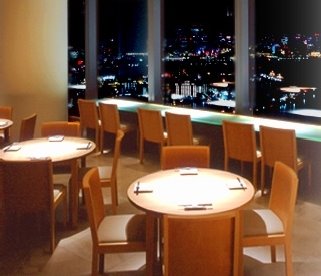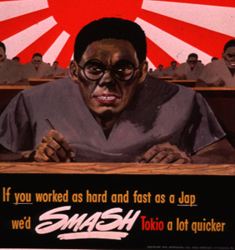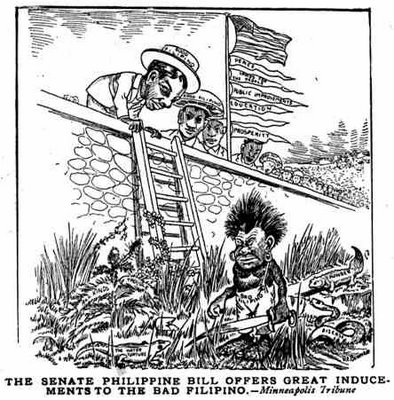Friday, June 30, 2006
Don't get me wrong, some of my best friends are poultry gender checkers...
The Guardian playing its role perfectly: "Spain's coach Luis Aragonés last night refused to apologise before this evening's second-round game against France in Hanover for racially abusing Thierry Henry in 2004, insisting rather bafflingly that he has "black, Gypsy and Japanese friends, including one whose job is to determine the sex of poultry".
Thursday, June 29, 2006
Saturday, June 24, 2006
Seeing how things are going...

Thought it would be best to get the England barbeque in quickly before England are chucked out on their ears from the World Cup. Thanks to Ma and Pa for the nationalist regalia birthday pressie. Our back garden made an odd sight. More Tooting Bec than Hiratsuka, Japan.
Perhaps my most unrelaxing drink

When God was installing the courage batteries he must have accidentally picked up a couple flat ones when he came to me.
A. and I had a romantic evening in Tokyo on Wednesday. Her Mum and Dad had given us a night off from the nappy changing and nose twisting as my birthday pressie. Unfortunately, the Turkish restaurant we had booked, called Marumara, turned out to be a bit of a disappointment. The food was OK, though not overly plentiful, but the service was appalling. The wine we ordered never arrived and by 9pm it became apparent that our visions of a relaxed evening supping the red stuff and talking nonsense were going awry (despite a generous supply of nonsense from my side of the table).
Anyway, the evening needed saving, so I hit on the bright idea of going to a bar with a really good view of Tokyo and having a couple of beers. The guidebook had a list of such establishments and we decided (after, let's admit it, a bit of a barney about my disappointment with Marumara) to go to Hibiki, a bar in Shiodome.

Well, not so much in Shiodome, as perched above it. After a great ride through the heart of Tokyo's newest skyscraper district on the Yurikamome or "swinging seagull", Tokyo's much more spectacular equivalent of London's Docklands Light Railway, it started to dawn on me that to get this spectacular view I was going to have to ascend 46 floors. That is a lot. I discovered there was a special express lift to get you up there and that they had kindly put it one the side of the building ... with glass sides. I had to stand with my back to the sensational view, my eyes fixed on the floor counter, as we zoomed heavenwards. A. seemed equally nervous. Once in Hibiki, we were led to our table: one of the best in the house, knees touching the glass, the sheer drop half a centimetre away. I ordered a beer, fixed a smile and, with a stiff neck, trained my eyes on the horizon. It was at this point that the interesting question about what exactly would happen if there was an earthquake occurred.

My batteries must not have been completely flat because I managed to bolt a second beer down a dry throat. By the time I was back at ground level, I was ecstatic. Hibiki's vertigo torture had turned around the evening. It will now be a fixture on my Tokyo tour for visitors. I might stay at the bottom though, if you don't mind.
(One symptom of my panic up there was that my photos were very blurred,
so I nicked some other people's pictures of the same views. )
so I nicked some other people's pictures of the same views. )
Tuesday, June 13, 2006
Wednesday, June 07, 2006
You know World Cup fever has bitten when...
... you ask your hotel reception (on a short trip to New England for my friend R.'s wedding) for directions to the "Stuart Pearce".
1. Stuart Pearce - England football hero and punk rocker, a.k.a. "Psycho".

2. Simon Pearce - A refined eatery in Vermont with one of the most spectacular views I have ever experienced in a restaurant.


Of course, the receptionist didn't get the humour behind my mistake, which kind of made it more funny. R.'s stag party was held at the restaurant. It was certainly one of the more sedate stags I have attended, perhaps bettered in that respect only by my own. The wedding itself was lovely, held at R.'s bride's parents' beautiful house, up a dirt track in the Vermont forest. I was really glad I went.
1. Stuart Pearce - England football hero and punk rocker, a.k.a. "Psycho".

2. Simon Pearce - A refined eatery in Vermont with one of the most spectacular views I have ever experienced in a restaurant.


Of course, the receptionist didn't get the humour behind my mistake, which kind of made it more funny. R.'s stag party was held at the restaurant. It was certainly one of the more sedate stags I have attended, perhaps bettered in that respect only by my own. The wedding itself was lovely, held at R.'s bride's parents' beautiful house, up a dirt track in the Vermont forest. I was really glad I went.
Fighting gooks, gu-gus, Japs, sand niggers and towel heads



The combination of racism and war invariably leads to horrific brutality on all sides. In my narrow area of interest, I have always been uncomfortable with the popular idea of generally well behaved Allied soldiers fighting uniformly barbaric Japanese soldiers in World War Two. This stinks of raw wartime propaganda to me. There were atrocities on both sides, and many many more by Allied soldiers than it is usual to admit. (Eg.)
Anyway, that is just a largely unresearched gut reaction on my part. This, however, is a very detailed examination of racism in the Philippine-American War, 40 years before World War Two. The article is about a specific point in US imperial and racial history. Generalising beyond that context is dangerous. The more I read, though, the more I saw broader insights and lessons.
General MacArthur declared in a December 1900 proclamation. “Mankind, from the beginning of civilization, however, has tried to mitigate, and to escape, as far as possible, from the consequences of this barbarous conception of warlike action...” [89] The Filipinos, in refusing these boundaries, had shown themselves to be less than “civilized.” “The war on the part of the Filipinos,” wrote Secretary of War Elihu Root, “has been conducted with the barbarous cruelty common among uncivilized races.”In the context of such rhetoric, the war quickly became racist and brutal on both sides.
In 1902, for example, Albert Gardner, in Troop B of the 1st U.S. Cavalry, composed a would-be comic song dedicated to “water-cure” torture—in which filthy water was poured into the mouths of Filipino prisoners, drowning them--sung to the tune of the Battle Hymn of the Republic:It was common to compare the slaughter of Philippinos to game hunting:
1st
Get the good old syringe boys and fill it to the brim
We’ve caught another nigger and we’ll operate on him
Let someone take the handle who can work it with a vim
Shouting the battle cry of freedom
Chorus
Hurrah Hurrah We bring the Jubilee
Hurrah Hurrah The flag that makes him free
Shove in the nozzel [sic] deep and let him taste of liberty
Shouting the battle cry of freedom. [93]
Private George Osborn of the 6th Infantry wrote home from Negros on January 15, 1900: “Just back from the fight. Killed 22 niggers captured 29 rifels [sic] and 1 shotgun and I tell you it was a fight… we just shot the niggers like a hunter would rabbits."Souvenir photography was commonplace:
Photographs of dead Filipino soldiers lying in trenches were often taken by U. S. soldiers and journalists and included in commemorative albums. Albert Sonnichsen wrote in his memoir of the “heaps of dead and dying natives… photographed by our people, and exhibited with such mottoes as: ‘Can the __d Regiment boys shoot? You bet they can. Count the dead niggers.’”Atrocities were explained away in racial terms:
Henry Cabot Lodge in an address before the Senate: "I think I know why these things have happened. I think they have grown out of the conditions of warfare, of the war that was waged by the Filipinos themselves, a semicivilized people, with all the tendencies and characteristics of Asiatics, with the Asiatic indifference to life, with the Asiatic treachery and the Asiatic cruelty, all tinctured and increased by three hundred years of subjection to Spain."We have come along way from that type of public rhetoric (they had not come so far in 1945), but have we left the terrible intersection of racism and war behind? (1, 2, 3)

Reading:
Race over Empire - Racism and U.S. Imperialism, 1865-1900 by Eric T.L.Love
The Blood of Government: Race, Empire, the United States, and the Philippines by Paul A. Kramer
War Without Mercy: Race and Power in the Pacific War by John W. Dower
Subscribe to:
Posts (Atom)